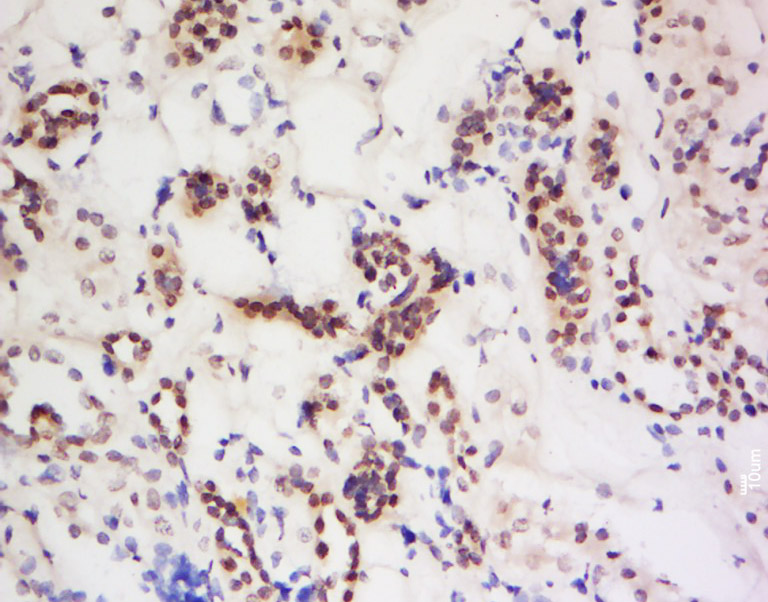
Rabbit Anti-PIWIL4 antibody
HILI 2; HILI2; HIWI 2; HIWI2; Miwi 2 protein; Miwi2; PIWI; Piwi like 2; Piwi like 4 (Drosophila); Piwi like 4; Piwi like protein 4; PIWI like protein; Piwi-like protein 4; PIWIL 4; Piwil4; PIWL4_HUMAN.
View History [Clear]
Details
Product Name PIWIL4 Chinese Name piwi样4蛋白抗体 Alias HILI 2; HILI2; HIWI 2; HIWI2; Miwi 2 protein; Miwi2; PIWI; Piwi like 2; Piwi like 4 (Drosophila); Piwi like 4; Piwi like protein 4; PIWI like protein; Piwi-like protein 4; PIWIL 4; Piwil4; PIWL4_HUMAN. Research Area Cell biology Developmental biology Chromatin and nuclear signals transcriptional regulatory factor Epigenetics Immunogen Species Rabbit Clonality Polyclonal React Species Human, (predicted: Mouse, Rat, Dog, Cow, Horse, Rabbit, Sheep, Monkey, ) Applications WB=1:500-2000 ELISA=1:5000-10000 IHC-P=1:100-500 IHC-F=1:100-500 IF=1:100-500 (Paraffin sections need antigen repair)
not yet tested in other applications.
optimal dilutions/concentrations should be determined by the end user.Theoretical molecular weight 94kDa Cellular localization The nucleus cytoplasmic Form Liquid Concentration 1mg/ml immunogen KLH conjugated synthetic peptide derived from human PIWIL4: 751-852/852 Lsotype IgG Purification affinity purified by Protein A Buffer Solution 0.01M TBS(pH7.4) with 1% BSA, 0.03% Proclin300 and 50% Glycerol. Storage Shipped at 4℃. Store at -20 °C for one year. Avoid repeated freeze/thaw cycles. Attention This product as supplied is intended for research use only, not for use in human, therapeutic or diagnostic applications. PubMed PubMed Product Detail PIWIL4 belongs to the Argonaute family of proteins, which function in development and maintenance of germline stem cells. Plays a central role during spermatogenesis by repressing transposable elements and prevent their mobilization, which is essential for the germline integrity. Acts via the piRNA metabolic process, which mediates the repression of transposable elements during meiosis by forming complexes composed of piRNAs and Piwi proteins and govern the methylation and subsequent repression of transposons. Directly binds piRNAs, a class of 24 to 30 nucleotide RNAs that are generated by a Dicer-independent mechanism and are primarily derived from transposons and other repeated sequence elements. Associates with secondary piRNAs antisense and PIWIL2/MILI is required for such association. The piRNA process acts upstream of known mediators of DNA methylation. Participates to a piRNA amplification loop. Besides their function in transposable elements repression, piRNAs are probably involved in other processes during meiosis such as translation regulation. May be involved in the chromatin-modifying pathway by inducing 'Lys-9' methylation of histone H3 at some loci.
Function:
Plays a central role during spermatogenesis by repressing transposable elements and prevent their mobilization, which is essential for the germline integrity. Acts via the piRNA metabolic process, which mediates the repression of transposable elements during meiosis by forming complexes composed of piRNAs and Piwi proteins and govern the methylation and subsequent repression of transposons. Directly binds piRNAs, a class of 24 to 30 nucleotide RNAs that are generated by a Dicer-independent mechanism and are primarily derived from transposons and other repeated sequence elements. Associates with secondary piRNAs antisense and PIWIL2/MILI is required for such association. The piRNA process acts upstream of known mediators of DNA methylation. Participates in a piRNA amplification loop. Besides their function in transposable elements repression, piRNAs are probably involved in other processes during meiosis such as translation regulation. May be involved in the chromatin-modifying pathway by inducing 'Lys-9' methylation of histone H3 at some loci.
Subunit:
Interacts with PRMT5 and WDR77. Interacts (when methylated on arginine residues) with TDRD1, TDRKH/TDRD2 and TDRD9.
Subcellular Location:
Nucleus. Cytoplasm. Note=Probable component of the meiotic nuage, also named P granule, a germ-cell-specific organelle required to repress transposon during meiosis. PIWIL2/MILI is required for nuclear localization.
Tissue Specificity:
Expressed in testis. According to PubMed:17544373, it is ubiquitously expressed.
Post-translational modifications:
Arginine methylation by PRMT5 is required for the interaction with Tudor domain-containing protein (TDRD1, TDRKH/TDRD2 and TDRD9) and subsequent localization to the meiotic nuage, also named P granule.
Similarity:
Belongs to the argonaute family. Piwi subfamily.
Contains 1 PAZ domain.
Contains 1 Piwi domain.
SWISS:
Q7Z3Z4
Gene ID:
143689
Database links:
UniProtKB/Swiss-Prot: Q7Z3Z4.2
Product Picture
Antigen retrieval: citrate buffer ( 0.01M, pH 6.0 ), Boiling bathing for 15min; Block endogenous peroxidase by 3% Hydrogen peroxide for 30min; Blocking buffer (normal goat serum,C-0005) at 37℃ for 20 min;
Incubation: Anti-PIWIL4 Polyclonal Antibody, Unconjugated(SL6853R) 1:200, overnight at 4°C, followed by conjugation to the secondary antibody(SP-0023) and DAB(C-0010) staining
Bought notes(bought amounts latest0)
No one bought this product
User Comment(Total0User Comment Num)
- No comment



 +86 571 56623320
+86 571 56623320




